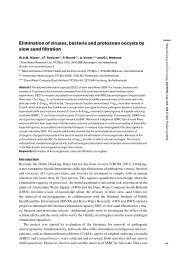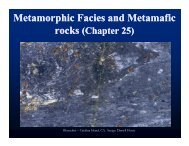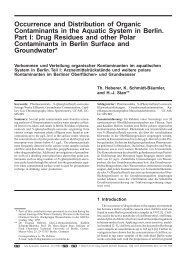Mantle melting and basalt generation
Mantle melting and basalt generation
Mantle melting and basalt generation
- No tags were found...
You also want an ePaper? Increase the reach of your titles
YUMPU automatically turns print PDFs into web optimized ePapers that Google loves.
Melting in the mantle2 principal types of <strong>basalt</strong> in the ocean basinsEach <strong>basalt</strong> type is chemically distinct <strong>and</strong> erupts at 1000-1200 CEvolve via fractional crystallization as separate series along different pathsImage source: Winter, 2001Tholeiites are most commonly generated at mid-ocean ridges, but alsooceanic isl<strong>and</strong>s <strong>and</strong> subduction zonesAlkaline <strong>basalt</strong>s are commonly generated at ocean isl<strong>and</strong>s, (some inoceanic isl<strong>and</strong>s).
Sources of knowledge of mantleHow do we know what the mantle is made of?(2) Dredge samples from oceanicfracture zones(3) Xenoliths in some <strong>basalt</strong>sSpinel harzburgite xenolith in alkali <strong>basalt</strong>. Image: Darrell Henry(4) KimberlitexenolithsDiamond-bearingpipes blasted up fromthe mantle carryingnumerous xenolithsfrom depth
Sources of knowledge of mantleWhat is the mineralogy of the mantle <strong>and</strong> what happensto it when it melts?Lherzolite:A type of peridotite withOlivine > Opx + Cpx.Other major peridotites ofthe mantle includeharzburgite <strong>and</strong> dunite.Image: John Winter (2001)
Sources of knowledge of mantleWhat is the mineralogy of the mantle <strong>and</strong> what happensto it when it melts?Image: John Winter (2001)For peridotites with similarcompositions, the stablealuminous phase changeswith ihdepth h(P) (P). Thealuminous phase is a modifierto peridotite.Al-phase• Plagioclaseshallow (< 30 km)Pl + Ol = Opx + Cpx + Sp• Spinel30-80 kmSp + Opx = Ol + Grt• Garnet80-400 km
Sources of knowledge of mantleWhat is the mineralogy of the mantle <strong>and</strong> what happensto it when it melts?Lherzolite is probably fertileundepleted mantle i.e. themantle that has little <strong>basalt</strong>icmelt extracted from it.Dunite (20-25% 25% partial <strong>melting</strong>)<strong>and</strong> harzburgite (15-20% partial<strong>melting</strong>) are refractory residuaafter <strong>basalt</strong> has been extracted bypartial <strong>melting</strong>Image: John Winter (2001)
Sources of knowledge of mantleHow does the mantle melt??(1) Increase T above normalgeotherm.• e.g. Radioactive decay of K, U orTh - but, these are in lowconcentration in mantle• local high heat flux at hot spots -however, these are localphenomenonImage: John Winter (2001)2) Lower the pressure• Adiabatic rise of mantle with noconductive heat loss• Decompression <strong>melting</strong> could meltup to 30% - particularly at MORs
Sources of knowledge of mantleHow do we generate tholeiitic <strong>and</strong> alkaline <strong>basalt</strong>s from achemically uniform mantle?Variables (other than X)• Temperature• Pressure• Minimum meltPressure changesIncreasing P moves the ternaryeutectic to more highly silicaundersaturated compositions i.e.will generate the alkali <strong>basalt</strong>sImage: John Winter (2001)
Sources of knowledge of mantlePrimary magmasMagmas formed at depth <strong>and</strong> not subsequently modified by fractionalcrystallization or assimilation.• generates derivative magmas.• Also the most primitive of a suite of magmas is termed parental, but itmay not be primary.Criteria to evaluate the possibleprimary nature of the magmaImage: John Winter (2001)• Highest Mg# (100Mg/(Mg+Fe))g or lowest SiO 2 , only definesparental magma• Experimental results of lherzolitemelts• 100*Mg/(Mg+Fe) g rock = 66-75%• Cr > 1000 ppm• Ni > 400-500 ppm
Sources of knowledge of mantleOceanic magmasThe positive slopes of theMORB must represent meltsderived from mantle that waspreviously depleted inincompatible elementsImage: John Winter (2001) increasing incompatibilityThe negative slopes of the OIBis due to partial <strong>melting</strong> of asource undepleted or enriched inincompatible elements
Sources of knowledge of mantleOceanic magmasThese potential melt sourcerocks indicate that there must beLREE enrichment in some ofthe peridotites rather thannondepletion increasing incompatibilityImage: John Winter (2001)
Sources of knowledge of mantleSummaryImage courtesy of Donald W. Forsyth, Brown University.(1) A chemically homogeneousmantle can yield a variety of<strong>basalt</strong> types(2) () Alkaline <strong>basalt</strong>s are favoredover tholeiites by deeper<strong>melting</strong> <strong>and</strong> by low % partialmelt(3) Fractionation at moderate tohigh depths can also createalkaline li <strong>basalt</strong>s from tholeiites(4) REE are very useful fordistinguishing gthe sourcerock/minerals of <strong>melting</strong>


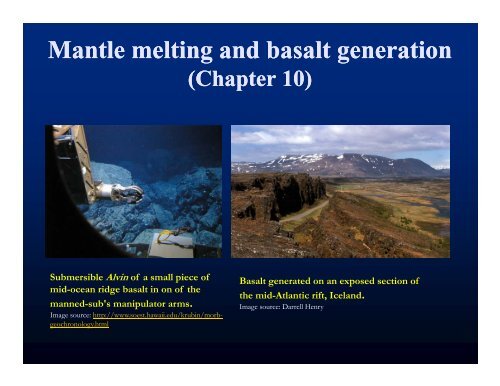


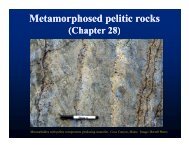
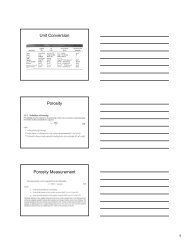


![21-IntroductionMetamorphism [Compatibility Mode].pdf](https://img.yumpu.com/32952021/1/190x146/21-introductionmetamorphism-compatibility-modepdf.jpg?quality=85)
